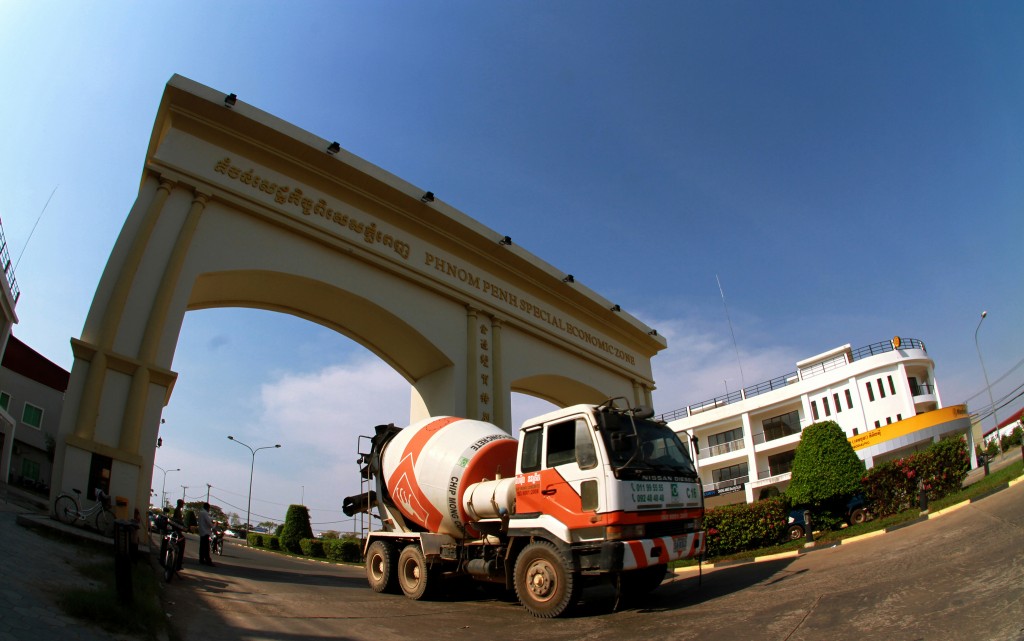
តំបន់សេដ្ឋកិច្ចពិសេស ភ្នំពេញ. រូបថត បានពី ធនាគារពិភពលោក ថត ១៩ កុម្ភៈ ២០១៣. អាជ្ញាប័ណ្ណ CC BY-NC-ND 2.0.
តំបន់សេដ្ឋកិច្ចពិសេស (SEZ) គឺជាតំបន់កំណត់មួយដែលត្រូវអនុលោមតាមច្បាប់ និងបទប្បញ្ញត្តិទាក់ទងជាច្រើន បើធៀបទៅនឹងតំបន់ផ្សេងទៀតក្នុងប្រទេសកម្ពុជា។ តំបន់ឧស្សាហកម្មដ៏ទូលំទូលាយទាំងនេះបានផ្តល់ ការលើកទឹកចិត្តអនុគ្រោះទៅកាន់វិនិយោគិននិងការគាំទ្រផ្នែករដ្ឋបាលសម្រាប់ការនាំចេញ-នាំចូល ដើម្បីសម្របសម្រួលដល់ការធ្វើពាណិជ្ជកម្ម។ ការបង្កើតតំបន់ទាំងនេះនាំឱ្យមានការអភិវឌ្ឍហេដ្ឋារចនាសម្ព័ន្ធយ៉ាងគួរឱ្យកត់សម្គាល់ជាច្រើន ហើយតំបន់ទាំងនេះត្រូវបានបង្កើតឡើងដើម្បីទាក់ទាញវិនិយោគទុនបរទេស ពង្រីកការប្រកួតប្រជែងជាសកល និងជំរុញការអភិវឌ្ឍសេដ្ឋកិច្ចជាតិ។ មានភាពមិនប្រាកដប្រជាជុំវិញតួរលេខនៃតំបន់សេដ្ឋកិច្ចពិសេសនៅក្នុងប្រទេសកម្ពុជា។ ក្រសួងការបរទេសអាមេរិកបានធ្វើកំណត់ត្រាតំបន់សេដ្ឋកិច្ចពិសេសដែលត្រូវបានចុះបញ្ជីចំនួន ៣៦ ក្នុងឆ្នាំ២០១៥។ 1 ខណៈអង្គការទិន្នន័យអំពីការអភិវឌ្ឍបានកំណត់ត្រាតំបន់សេដ្ឋកិច្ចពិសេសចំនួន ៤៦ ត្រឹមខែ កញ្ញា ឆ្នាំ ២០២០។ (សូមចូលទៅកាន់ទិន្នន័យក្រុមហ៊ុនក្នុងតំបន់សេដ្ឋកិច្ចពិសេសនៅត្រង់នេះ)។
គោលនយោបាយ
ក្នុងផែនការយុទ្ធសាស្ត្រអភិវឌ្ឍន៍ជាតិឆ្នាំ២០១៤-២០១៨ រដ្ឋាភិបាលកម្ពុជាមានគោលបំណង “កៀរគរធនធានមនុស្ស ហិរញ្ញវត្ថុ និងស្ថាប័នធនធានដើម្បីជួយដល់ការបង្កើតឧស្សាហកម្មថ្មី”។ការកំណត់នេះនាំឱ្យមានការបង្កើតនិងការពង្រឹងតំបន់សេដ្ឋកិច្ចពិសេសដើម្បីទាក់ទាញវិនិយោគទុនបរទេស ជំរុញការផ្ទេរបច្ចេកវិទ្យានិងពង្រីកទីផ្សារនាំចេញ។2ក្រុមប្រឹក្សាអភិវឌ្ឍន៍កម្ពុជាក៏មានគម្រោងពង្រឹងការអនុវត្តតំបន់សេដ្ឋកិច្ចពិសេសនិងធានាថាទីតាំងរបស់តំបន់ទាំងនេះមានលក្ខណៈសមស្រប “សម្រាប់ការបង្កើនសមាហរណកម្មសេដ្ឋកិច្ចកម្ពុជាទៅក្នុងតំបន់ជាអតិប្បរមា”។3របាយការណ៍រដ្ឋាភិបាលឆ្នាំ ២០១២ស្តីអំពីគោលនយោបាយដីធ្លី បានណែនាំថា ការអភិវឌ្ឍនៃតំបន់សេដ្ឋកិច្ចពិសេសគួរផ្សារភ្ជាប់ទៅនឹងគោលនយោបាយលំនៅដ្ឋានដើម្បីបញ្ចៀសការធ្វើចំណាកស្រុកដើម្បីស្វែងរកការងារធ្វើ និងធានារបាយផលប្រយោជន៍នៃការអភិវឌ្ឍសេដ្ឋកិច្ចប្រកបដោយសមធម៌ ក្នុងចំណោម ទីតាំងភូមិសាស្ត្រក្នុងតំបន់។4
ក្របខណ្ឌគតិយុត្តិ
តំបន់សេដ្ឋកិច្ចពិសេសស្ថិតនៅក្រោមវិសាលភាពនៃច្បាប់វិនិយោគ និងត្រូវបានបង្កើតឡើងជាផ្លូវការនៅឆ្នាំ២០០៥ ដោយអនុក្រឹត្យលេខ១៤៨ ស្តីពីការបង្កើតនិងគ្រប់គ្រងតំបន់សេដ្ឋកិច្ចពិសេស។ តំបន់ទាំងនេះមានគោលបំណងកែលម្អបរិយាកាសវិនិយោគនៅកម្ពុជាដើម្បីពង្រឹង “ផលិតភាព ភាពប្រកួតប្រជែង កំណើនសេដ្ឋកិច្ចជាតិ ជំរុញការនាំចេញ ការបង្កើតការងារដើម្បីកាត់បន្ថយភាពក្រីក្រ”។5
តំបន់សេដ្ឋកិច្ចពិសេសគឺជាគម្រោងវិនិយោគមានគុណវឌ្ឍន៍ (QIP) ដែលជាគម្រោងដែលទទួលបានវិញ្ញាបនបត្រពីក្រុមប្រឹក្សាអភិវឌ្ឍន៍កម្ពុជា និងទទួលបានផលប្រយោជន៍ពីការលើកទឹកចិត្តហិរញ្ញវត្ថុដែលផ្តល់ដោយរដ្ឋាភិបាល។6អ្នកអភិវឌ្ឍតំបន់សេដ្ឋកិច្ចពិសេស និងវិនិយោគិនទទួលបានការលើកទឹកចិត្តអនុគ្រោះ ដូចជាការលើកលែងពន្ធប្រាក់ចំណូលសម្រាប់រយៈពេល ៩ ឆ្នាំការលើកលែងពន្ធនាំចូលសម្រាប់គ្រឿងបរិក្ខាសម្រាប់សាងសង់តំបន់ ការលើកលែងពន្ធតម្លៃបន្ថែម គ្មានការរិតត្បិតលើរូបិយប័ណ្ណ និងការធានាចំពោះជាតូបនីយកម្ម និងការគ្រប់គ្រងថ្លៃ។ ខណៈដែលគម្រោង QIPs ក្នុងតំបន់សេដ្ឋកិច្ចពិសេសទទួលបានការលើកទឹកចិត្តហិរញ្ញវត្ថុដូចគ្នានឹងគម្រោង QIPs នៅក្រៅតំបន់សេដ្ឋកិច្ចពិសេស តំបន់សេដ្ឋកិច្ចពិសេសទទួលបានផលប្រយោជន៍ពីយន្តការ “សេវានៅនឹងកន្លែង” ដែលជំរុញដំណើរការនាំចេញ-នាំចូល។7
ស្ថិតក្រោមបទប្បញ្ញត្តិនៃក្រុមប្រឹក្សាអភិវឌ្ឍន៍កម្ពុជា ក្រុមប្រឹក្សាតំបន់សេដ្ឋកិច្ចពិសេសកម្ពុជា (CSEZB) គឺជានិយ័តករចម្បងនៃតំបន់សេដ្ឋកិច្ចពិសេស។ ក្រុមប្រឹក្សានេះទទួលខុសត្រូវលើការអភិវឌ្ឍ គ្រប់គ្រង និងត្រួតពិនិត្យដំណើការរបស់តំបន់សេដ្ឋកិច្ចពិសេស និងកំណត់ការលើកទឹកចិត្តអនុគ្រោះដែលមានសម្រាប់តំបន់សេដ្ឋកិច្ចពិសេស។ តំបន់សេដ្ឋកិច្ចពិសេសនីមួយៗមានរការិយាល័យរដ្ឋបាលតំបន់សេដ្ឋកិច្ចពិសេសនៅនឹងកន្លែង ដែលមានតួនាទីជាយន្តការ “សេវានៅនឹងកន្លែង” ដើម្បីសម្រួលដំណាក់ការពន្ធគយនិងជំរុញដំណើរការនាំចេញ-នាំចូល។ បន្ថែមពីនេះ គណៈកម្មាធិការកំណត់បញ្ហាតំបន់សេដ្ឋកិច្ចពិសេស (SEZ TSC) ទទួលបណ្តឹងពីអ្នកអភិវឌ្ឍ និងវិនិយោគិន និងមានតួនាទីដោះស្រាយបញ្ហា។8
តំបន់សេដ្ឋកិច្ចពិសេសត្រូវបានបង្កើត និងសាងសង់ដោយអ្នកអភិវឌ្ឍតំបន់ ដែលទទួលឲ្យវិនិយោគិនជួលទីតាំងក្នុងតំបន់។ អ្នកអភិវឌ្ឍតំបន់ទទួលខុសត្រូវលើការសាងសង់ហេដ្ឋារចនាសម្ព័ន្ធទាំងអស់ ដែលត្រូវរួមបញ្ចូលការគ្រប់គ្រងអគារការិយាល័យ ការិយាល័យរដ្ឋបាលតំបន់ ផ្លូវថ្នូល់ ទឹកស្អាតនិងប្រព័ន្ធលូ ការចោលកាកសំណល់ ការផ្គត់ផ្គង់អគ្គីសនី និងបណ្តាញទូរគមនាគមន៍ ការការពារអគ្គីភ័យ និងប្រព័ន្ធសន្តិសុខ។9អ្នកអភិវឌ្ឍន៍ត្រូវបំពេញតាមលក្ខខណ្ឌជាក់លាក់ដើម្បីធានាថា ពួកគេមានសមត្ថភាពក្នុងការផ្តល់ហេដ្ឋារចនាសម្ព័ន្ធ និងសេវាទូលំទូលាយនេះ ដូចជា ការមានសិទ្ធិស្របច្បាប់ក្នុងការកាន់កាប់ដីធ្លី។10 អ្នកអភិវឌ្ឍតំបន់ទទួលខុសត្រូវលើការបង្កើតវិធានសម្រាប់តំបន់សេដ្ឋកិច្ចពិសេស ដោយផ្តល់សន្តិសុខ និងរក្សាសណ្តាប់ធ្នាប់សាធារណៈ ក្នុងចំណោមកាតព្វកិច្ចផ្សេងទៀត។11
អ្នកអភិវឌ្ឍតំបន់អាចទទួលបានដីសម្រាប់ប្រតិបត្តិការតំបន់សេដ្ឋកិច្ចពិសេស តាមវិធីមួយក្នុងចំណោមវិធីពីរយ៉ាង។ ជនជាតិ និងនីតិបុគ្គលកម្ពុជាអាចកាន់កាប់ដីធ្លីដើម្បីប្រតិបត្តិការតំបន់សេដ្ឋកិច្ចពិសេស ឬពួកគេអាចជួលដីតាមរយៈសម្បទាន។12ច្បាប់ដីធ្លីមិនអនុញ្ញាតិឱ្យជនជាតិបរទេសឬនីតិបុគ្គលបរទេសកាន់កាប់ដីធ្លីបានឡើយ។13អាស្រ័យហេតុនេះជនជាតិ ឬនីតិបុគ្គលបរទេសត្រូវជួលដី ឬទទួលបានសម្បទានដើម្បីអនុវត្តគម្រោងតំបន់សេដ្ឋកិច្ចពិសេស។14
វិនិយោគិននិងម្ចាស់ពាណិជ្ជកម្មដែលជួលដីក្នុងតំបន់សេដ្ឋកិច្ចពិសេសទទួលបានអត្ថប្រយោជន៍ដូចជា ហេដ្ឋារចនាសម្ព័ន្ធកាន់តែល្អប្រសើរ សង្វាក់ការដឹកជញ្ជូនទំនិញមានប្រសិទ្ធភាពជាងមុននិងលក្ខខណ្ឌសេដ្ឋកិច្ច ដែលមានលក្ខណៈសេរីជាងតំបន់ផ្សេងទៀតក្នុងប្រទេស។ គោលនយោបាយអនុគ្រោះ និងការលើកទឹកចិត្តមានលក្ខខណ្ឌដូចគ្នាសម្រាប់គម្រោងវិនិយោគមានគុណវឌ្ឍន៍ (QIP) ទាំងនៅក្នុងនិងក្រៅតំបន់សេដ្ឋកិច្ចពិសេស។យ៉ាងណាមិញ តំបន់សេដ្ឋកិច្ចពិសេសទទួលបានជំនួយពីរដ្ឋាភិបាល ជាពិសេសតាមរយៈ “សេវានៅនឹងកន្លែង”។ ក្រៅពីនេះ ពួកគេអាចទទួលបានជំនួយពីអ្នកអភិវឌ្ឍតំបន់ ដែលទទួលខុសត្រូវលើការងារគាំពារទូទៅ និងដើរតួនាទីជា បណ្តាញទំនាក់ទំនងជាមួយរដ្ឋាភិបាល។ អ្នកអភិវឌ្ឍអាចផ្តល់ការបណ្តុះបណ្តាលទៅលើកម្លាំងពលកម្ម និងការអភិវឌ្ឍជំនាញផងដែរ។15
តំបន់សេដ្ឋកិច្ចក្នុងប្រទេសកម្ពុជា
អ្នកវិនិយោគភាគច្រើនមកពីប្រទេសកម្ពុជា ជប៉ុន ចិន ថៃនិងតំបន់តៃវ៉ាន់។16សកម្មភាពសេដ្ឋកិច្ចដែលមានលក្ខណៈរួមគឺឧស្សាហកម្មធនស្រាល ដែលត្រូវបានកំណត់ថា ជាសកម្មភាពពលកម្មសកម្មជាមួយគ្រឿងចក្រស្វ័យប្រវត្តិនិងម៉ាស៊ីន ប្រព័ន្ធអេឡិចត្រូនិកនិងគ្រឿងអេឡិចត្រូនិក និងសកម្មភាពជួបប្រជុំជាច្រើនផ្សេងៗទៀត។17ក្នុងឆ្នាំ២០១៤ មានវិនិយោគិនច្រើនជាងពាក់កណ្តាលដែលធ្វើការផលិតឧស្សាហកម្មធនស្រាលសម្រាប់ការនាំចេញ ដែលក្នុងនោះ មួយភាគប្រាំជាផលិតកម្មវាយនភណ្ឌ។18
តំបន់សេដ្ឋកិច្ចពិសេសកំពូលទាំងប្រាំនៅក្នុងប្រទេសកម្ពុជាក្នុងចំណោមតំបន់សេដ្ឋកិច្ចទាំង ៤៦ ដែលមានក្នុងទិន្នន័យរបស់អង្គការទិន្នន័យអំពីការអភិវឌ្ឍ(ODC) មានតំបន់សេដ្ឋកិច្ចពិសេសចំនួន ៥ ដែលបានធ្វើប្រតិបត្តិការនៅលើផ្ទៃដីទំហំប្រមាណ ៤,៤០០ហិកតា និងអះអាងថាមានទុនវិនិយោគច្រើនជាង១០០លានដុល្លារសម្រាប់តំបន់សេដ្ឋកិច្ចពិសេសនីមួយៗ។ តំបន់សេដ្ឋកិច្ចពិសេសក្រុងព្រះសីហនុ ១ តំបន់សេដ្ឋកិច្ចពិសេសក្រុងព្រះសីហនុ ២ និងតំបន់សេដ្ឋកិច្ចពិសេសកំពង់សោម មានទុនវិនិយោគគិតបញ្ជូលគ្នាសរុបចំនួន ៦១០លានដុល្លារ ដែលស្ថិតនៅក្នុងខេត្តព្រះសីហនុដែលជាខេត្តជាប់ឆ្នេរ និងមានកំពង់ផែធំជាងគេក្នុងប្រទេសកម្ពុជា។ តំបន់សេដ្ឋកិច្ចពិសេសធំជាងគេគឺតំបន់សេដ្ឋកិច្ចពិសេសក្រុងព្រះសីហនុ (SSEZ) ដែលបានបង្កើតឡើងក្នុងឆ្នាំ ២០០៨។ វាគ្របដណ្តប់លើផ្ទែដី ៥២៥ ហិកតា នៅក្នុងដំណាក់កាលដំបូងនៃការអភិវឌ្ឍ។ មានជនជាតិចិនប្រហែលជា ១១០ នាក់ដែលបាននឹងកំពុងស្នាក់នៅក្នុងតំបន់សេដ្ឋកិច្ចពិសេសនេះ។ មានរោងចក្រចំនួន ៩៣ កំពុងដំណើរការ ហើយផ្តល់ជាការងារដល់មនុស្សចំនួន ១៦.០០០ នាក់។ ក្រុមហ៊ុនបាននិយាយកាលពីពាក់កណ្តាលឆ្នាំ ២០១៧ ថាខ្លួនកំពុងធ្វើការដើម្បីអភិវឌ្ឍតំបន់ដែលមានទំហំ ៦០០ ហិកតានៅតំបន់នោះ។ ការអភិវឌ្ឍនេះមានគោលបំណងដើម្បីបង្កើតជាកន្លែងអាជីវកម្មចំនួន ៣០០ ដែលនឹងប្រើប្រាស់និយោជិកសរុបយ៉ាងតិច ៧ ម៉ឺននាក់ក្នុងរយៈពេល ៥ ឆ្នាំ។19 តំបន់សេដ្ឋកិច្ចពិសេសចំនួន២ក្នុងខេត្តកោះកុង គឺតំបន់សេដ្ឋកិច្ចពិសេសរតនា និងតំបន់សេដ្ឋកិច្ចពិសេសកោះកុងគីរីសាគរ មានទុនវិនិយោគគិតបញ្ជូលគ្នាសរុបជិត១៧៣លានដុល្លារនិង១១១លានដុល្លារ បន្តបន្ទាប់គ្នា។ វិនិយោគិនភាគច្រើនក្នុងតំបន់សេដ្ឋកិច្ចពិសេសគឺជាក្រុមហ៊ុនមកពីអាស៊ី និងមានក្រុមហ៊ុនមួយចំនួនតូចផ្សេងទៀតមកពីប្រទេសអូស្ត្រាលី ប៊ែលហ្សិកនិងអាមេរិក។ បញ្ហាប្រឈមធំជាងគេសម្រាប់តំបន់សេដ្ឋកិច្ចពិសេសដែលគ្របដណ្តបប្រមាណ ៨៥ ភាគរយនៃផ្ទៃដីនេះគឺតម្លៃអគ្គិសនីខ្ពស់និងការចាយវាយមិនផ្លូវការ។ |
បញ្ហាប្រឈម និងទិសដៅអនាគត
តំបន់សេដ្ឋកិច្ចពិសេសត្រូវបានប្រមូលផ្តុំនៅតាមតំបន់មួយចំនួនតែប៉ុណ្ណោះនៅក្នុងប្រទេស។ ជានិច្ចកាល តំបន់ទាំងនេះទទួលបាន សេវាដឹកជញ្ជូននិងទូរគមនាគមន៍ដែលជាហេដ្ឋារចនាសម្ព័ន្ធមានការខ្វះខាតនៅតំបន់ផ្សេងទៀតនៃប្រទេស។ពេលខ្លះ តំបន់ទាំងនេះមានព្រំដែនរួមជាមួយប្រទេសវៀតណាមនិងថៃ។តំបន់សេដ្ឋកិច្ចពិសេសបានជួយសម្របសម្រួលពាណិជ្ជកម្មអន្តរជាតិនិងកាត់បន្ថយថ្លៃឈ្នួលសម្រាប់ការដឹកជញ្ជូននិងថ្លៃឈ្នួលបរិក្ខារ។
យ៉ាងណាមិញ ដោយសារគោលនយោបាយរដ្ឋាភិបាលមានគោលបំណងបញ្ចៀសការធ្វើចំណាកស្រុក ដើម្បីស្វែងរក ការងារនិងចែករំលែក“ភាគលាភនៃផលប្រយោជន៍នៃការអភិវឌ្ឍប្រកបដោយសមភាព”ទៅកាន់ប្រជាពលរដ្ឋដែលស្ថិតនៅក្នុងតំបន់មានការរីកចម្រើនតិចតួចនៅក្នុងប្រទេសកម្ពុជា កត្តាប្រឈមនៃការប្រមូលផ្តុំនេះនៅតែកើតមានដដែល។20
ខណៈតម្លៃអគ្គីសនីខ្ពស់ធ្វើឲ្យមានកំណើនដើមទុនផលិតកម្មដែលធ្វើឱ្យតំបន់សេដ្ឋកិច្ចពិសេសកម្ពុជា មានភាព ប្រកួតប្រជែងតិចជាងបណ្តាប្រទេសជិតខាង ការដាច់ភ្លើងនៅតែកើតមានឡើងជារឿយៗ ដែលនេះបានបង្កើត ជាផលលំបាកបន្ថែម។លើសពីនេះ ការចំណាយក្រៅផ្លូវការដែលនឹកស្មានមិនដល់ មិនត្រឹមតែបង្កើនដើមទុនផលិតកម្មនោះទេ កត្តានេះថែមទាំងនាំឱ្យអ្នកវិនិយោគប្រព្រឹត្តទង្វើមិនស្មោះត្រង់ដែលពាក់ព័ន្ធនឹង”ការប្រកួតប្រជែងមិនសុក្រឹត្យ”ទៀតផង។ឧទាហរណ៍ ប្រធានមន្ត្រីប្រតិបត្តិការនៃតំបន់សេដ្ឋកិច្ចពិសេសភ្នំពេញបានរាយការណ៍ថា ទឹកប្រាក់បន្តិចបន្តួចត្រូវបានបញ្ចូលទៅក្នុងវិក្កយប័ត្រក្រៅផ្លូវការ។21
តំបន់សេដ្ឋកិច្ចពិសេសមានសក្តានុពលគួរឱ្យកត់សម្គាល់ក្នុងការទាក់ទាញវិនិយោគទុនបរទេស។ យោងតាមធនាគារអភិវឌ្ឍអាស៊ី មានតំបន់សេដ្ឋកិច្ចពិសេសចំនួន៩ដែលបានចូលរួមក្នុងការស្ទាបស្ទង់មតិ។ការងារស្រាវជ្រាវនេះបានរកឃើញថា តំបន់ទាំងនេះបានបង្កើតការងារចំនួន៦៨,០០០កន្លែងក្នុងឆ្នាំ២០១៤។22 យ៉ាងណាមិញ តំបន់សេដ្ឋកិច្ចពិសេសទាំងនេះមានសមត្ថភាពក្នុងការបង្កើតមុខរបរបានច្រើនជាងនេះ។ជាតួយ៉ាង តំបន់សេដ្ឋកិច្ចពិសេសភ្នំពេញតែមួយកន្លែងប៉ុណ្ណោះអាចមានសមត្ថភាពក្នុងការបង្កើតការងារចំនួន៨០,០០០កន្លែងក្នុងរោងចក្រចំនួន២០០។23ក៏ប៉ុន្តែ ត្រឹមខែមេសាឆ្នាំ២០១៦ មានពលករចំនួន១៩៨៣៧នាក់តែប៉ុណ្ណោះនៅក្នុងតំបន់នេះ។24
ធ្វើបច្ចុប្បន្នភាពចុងក្រោយ៖ ៣០ កញ្ញា ២០២០
ពាក់ព័ន្ធនឹងតំបន់សេដ្ឋកិច្ចពិសេស
ឯកសារយោង
- 1. ក្រសួងការបរទេសអាមេរិក «របាយការណ៍បរិយាកាសវិនិយោគនៅកម្ពុជា» ឆ្នាំ ២០១៥។
- 2. ផែនការយុទ្ធសាស្រ្តអភិវឌ្ឍន៍ជាតិឆ្នាំ ២០១៤-២០១៨, ទំព័រ៩៦
- 3. ដូចឯកសារយោងខាងលើ, ១៦៤
- 4. របាយការណ៍រដ្ឋាភិបាលស្តីពីគោលនយោបាយដីធ្លីឆ្នាំ ២០១២ ទំព័រ ២៩
- 5. អនុក្រឹត្យលេខ ១៤៨ មាត្រា ១
- 6. ក្រសួងពាណិជ្ជកម្មកម្ពុជា “យុទ្ធសាស្រ្តសមាហរណកម្មពាណិជ្ជកម្មវិនិច្ឆ័យកម្ពុជាឆ្នាំ ២០១៤-២០១៨”, ឆ្នាំ ២០១៤។
- 7. អនុក្រឹត្យលេខ ១៤៨ មាត្រា ៦-៧
- 8. ដូចឯកសារយោងខាងលើ,មាត្រា៤
- 9. ដូចលេខយោងខាងលើ មាត្រា ៣
- 10. ដូចឯកសារយោងខាងលើ មាត្រា ៤
- 11. ដូចឯកសារយោងខាងលើ
- 12. ច្បាប់ស្តីពីវិសោធនកម្មច្បាប់វិនិយោគរបស់ព្រះរាជាណាចក្រកម្ពុជា ឆ្នាំ ២០០៣ មាត្រា ១៦
- 13. ច្បាប់ភូមិបាលឆ្នាំ ២០០១ មាត្រា ៨
- 14. ច្បាប់ស្តីពីវិសោធនកម្មច្បាប់វិនិយោគរបស់ព្រះរាជាណាចក្រកម្ពុជា ឆ្នាំ ២០០៣ មាត្រា ១៦
- 15. ក្រសួងពាណិជ្ជកម្ម “យុទ្ធសាស្ត្រវិនិច្ឆ័យសមាហរនកម្មពាណិជ្ជកម្មកម្ពុជាឆ្នាំ ២០១៤-២០១៨” ឆ្នាំ ២០១៤។ ចូលអាននៅថ្ងៃទី ១៤ ខែមិថុនា ឆ្នាំ ២០១៦
- 16. ដូចឯកសារយោងខាងលើ
- 17. ដូចឯកសារយោងខាងលើ, ២១៩.
- 18. ដូចឯកសារយោងខាងលើ,២៣៧.
- 19. Cam McGrath, “តំបន់សេដ្ឋកិច្ចពិសេសដែលធំជាងគេនៅកម្ពុជានឹងមានទំហំកាន់តែធំជាងមុន“, ថ្ងៃទី ១៤ ខែ កញ្ញា ឆ្នាំ ២០១៧។ ចូលអាននៅថ្ងៃទី ២៥ ខែ កញ្ញា ឆ្នាំ ២០១៧។
- 20. Whitehead, James “សក្តានុពលការវិនិយោគនៅតំបន់សេដ្ឋកិច្ចពិសេសផ្អែកលើហេដ្ឋារចនាសម្ព័ន្ធ” ថ្ងៃទី ០៩ ខែកក្កដា ឆ្នាំ ២០១៥។
- 21. Rollet, Charles “មជ្ឈមណ្ឌលជំនួញនឹងដោះស្រាយបញ្ហាប្រឈមចម្បងៗ មុនពេលចុះបញ្ជី” ថ្ងៃទី ១៤ ខែកុម្ភៈ ឆ្នាំ ២០១៥។
- 22. Peter Warr និង Jayant Menon “តំបន់សេដ្ឋកិច្ចពិសេសនៅក្នុងប្រទេសកម្ពុជា” ឆ្នាំ ២០១៥។ ចូលអាននៅថ្ងៃទី ១០ ខែមិថុនា ឆ្នាំ ២០១៦។
- 23. Whitehead, James “សក្តានុពលការវិនិយោគនៅតំបន់សេដ្ឋកិច្ចពិសេសផ្អែកលើហេដ្ឋារចនាសម្ព័ន្ធ” ថ្ងៃទី ០៩ ខែកក្កដា ឆ្នាំ ២០១៥។
- 24. សុវណ្ណ ដេត “តំបន់សេដ្ឋកិច្ចពិសេសភ្នំពេញ៖ មានក្រុមហ៊ុនវិនិយោគចុះបញ្ជីចំនួន ៨៤” ថ្ងៃទី ០៦ ខែ មិថុនា ឆ្នាំ ២០១៦។ ចូលអាននៅថ្ងៃទី ១៤ ខែមិថុនា ឆ្នាំ ២០១៦។

